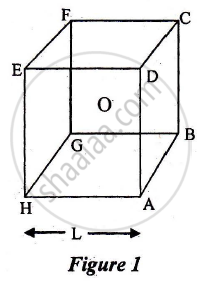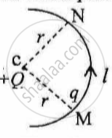Advertisements
Advertisements
Calculate mass defect and binding energy per nucleon of `"_10^20 Ne`, given
Mass of `"_10^20 Ne= 19.992397` u
Mass of `"_0^1H = 1.007825` u
Mass of `"_0^1n = 1.008665` u
Concept: Mass-energy and Nuclear Binding Energy > Nuclear Binding Energy
What is the use of Zener diode?
Concept: Semiconductor Diode
A short electric dipole (which consists of two point charges, +q and -q) is placed at the centre 0 and inside a large cube (ABCDEFGH) of length L, as shown in Figure 1. The electric flux, emanating through the cube is:

a) `q"/"4piin_9L`
b) zero
c) `q"/"2piin_0L`
d) `q"/"3piin_0L`
Concept: Electric Dipole
What is meant by the term Quantization of charge?
Concept: Quantisation of Charge
Derive an expression for the intensity of electric field at a point in broadside position or on [4)
an equatorial line of an electric dipole.
Concept: Electric Dipole
A closed surface in vacuum encloses charges –q and +3q. The total electric flux emerging out of the surface is :
Concept: Applications of Gauss’s Law
Maximum torque acting on an electric dipole of moment 3×10-29 Cm in a uniform electric field E is 6 × 10-25 Nm. Find E.
Concept: Dipole in a Uniform External Field
The intensity of the electric field at a perpendicular distance of 0·5 m from an infinitely long line charge having linear charge density (λ) is 3-6 × 103 Vm-1. Find the value of λ.
Concept: Electric Field Lines
The intensity of the electric field at a point at a perpendicular distance ‘r’ from an infinite line charge, having linear charge density ‘λ’ is given by:
Concept: Electric Field Due to a Point Charge
In Figure 1 below, a charge Q is fixed. Another charge q is moved along a circular arc MN of radius r around it, from the point M to the point N such that the length of the arc MN = l. The work done in this process is:

figure 1
Concept: Basic Properties of Electric Charge
A charged oil drop weighing 1.6 x 10-15 N is found to remain suspended in a uniform electric field of intensity 2 x 103 Nc-1. Find the charge on the drop.
Concept: Electric Field Due to a Point Charge
Two-point charges Q1 = 400 μC and Q2 = 100 μC are kept fixed, 60 cm apart in a vacuum. Find the intensity of the electric field at the midpoint of the line joining Q1 and Q2.
Concept: Electric Dipole
State Gauss’Law.
Concept: Applications of Gauss’s Law
In an electric dipole, at which point is the electric potential zero ?
Concept: Electric Dipole
A hollow sphere of radius R has a point charge Q at its centre. Electric flux emanating from it is `phi`. If both the charge and the radius of the sphere are doubled, electric flux emanating from the sphere will ______.
Concept: Electric Flux
Show that intensity of electric field at a point in broadside position of an electric dipole is given by:
E = `(1/(4piepsilon_0)) "p"/(("r"^2 + l^2)^(3//2))`
Where the terms have their usual meaning.
Concept: Electric Dipole
In an electric dipole, what is the locus of a point having zero potential?
Concept: Electric Dipole
A hollow sphere of radius R has a point charge q at its centre. Electric flux emanating from the sphere is X. How will the electric flux change, if at all, when radius of the sphere is doubled?
Concept: Electric Flux
A hollow sphere of radius R has a point charge q at its centre. Electric flux emanating from the sphere is X. How will the electric flux change, if at all, when charge q is replaced by an electric dipole?
Concept: Electric Flux
In case of an infinite line charge, how does intensity of electric field at a point change, if at all, when.
- charge on it is doubled?
- distance of the point is halved?
Concept: Electric Field Due to a Point Charge
